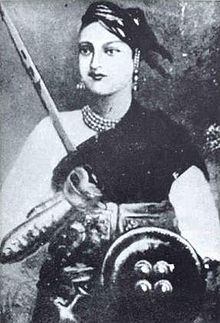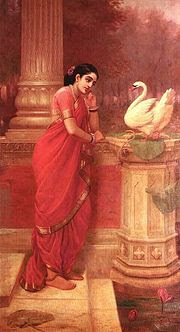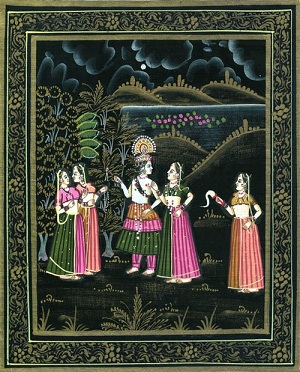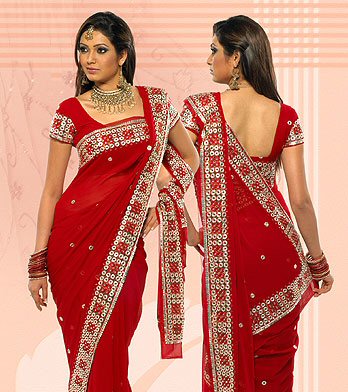The saree is one of the world’s oldest and perhaps the only surviving unstitched garment from the past. Over the millennia, it has not only become a sensuous, glamorous all-time-wear for women, but also the ‘canvas’ for weavers and printers to create artistic weaves, prints and jewelled or gold-silver embellishments!
They say cotton and the art of weaving it into fabric came to India from the Mesopotamian civilisation. The men and women of the contemporary Indus Valley Civilisation were therefore familiar with cotton fabrics and wore long pieces of material which could best be described as loin cloths. These lengths of fabric were worn in the kachcha style, meaning that after draping it around the waist, the wearer passed one end of the cloth or the centre pleat between the legs and tucked it up behind to facilitate freer movement of the lower body and the legs. Early history records that this style of clothing was not only limited to Mesopotamia or the Indus Valley but was common to Egypt, Sumer, and Assyria. The relics of all these civilisations, now available in seals and figurines, prove this fact. Women of most of these civilisations, it seems from available evidence, wore only such loin cloths, leaving the upper part of the body bare, except in winter when animal skins or woollen shawl-like garments were used for protection from harsh weather.
When the Aryans came into the plains of the mighty north Indian rivers, they brought with them the word vastra for the first time. Though a Sanskrit word originally meaning a garment or cloth, for them it was a piece of treated leather made into wearable clothing. Their wardrobes also included woollen clothing as they lived in colder climates. As they moved southwards, they adopted the practice of wearing cotton weaves, in the manner of the Indus Valley inhabitants. In time, this style of wearing a length of cloth around the waist, especially for women, and the cloth itself came to be known as neevi. Therefore, it is quite likely that the simple loin cloth worn by the women of the Indus Valley civilisation was the early precursor of the many-splendoured saree of India.
In the epics of India, which were written much after the Indus Valley period, several assorted items of dress were described. The kanchuki, mentioned in many of the legends which form the narrative of the epics, was a piece of cloth worn across the breasts by women. It was probably the earliest form of the choli. Many women, featuring in the classical literature generated by the epics, were described as beautiful in clothes made from silks encrusted with gold and gems.
Yellow silk neevis called Pitambar and purple silk shawls called Patola were considered auspicious. Though there were some elementary stitched garments, the neevi and the kanchuki remained the major mode of apparel for women. The art of dyeing these fabrics with vegetable dyes originated with the need of wealthier people in society to wear fancier clothes. By the time the epic era came to a close, women were wearing extraordinarily beautiful clothes with ornate embroidery. They wore exquisite jewellery too. The word Patta for silk seems to have originated during this time and todate, carries the same meaning in Telegu, Tamil, Kannada as well as in several south Indian dialects.
As if to better use these arts of dyeing and embroidery, the normal outfit of a woman progressively became a three part ensemble. The lower garment wrapped around the waist was the neevi. The kanchuki covered the breasts and a shawl-like garment, called the Uttariya, completed the outfit. Many a time, these shawl-like Uttariyas were worn to cover the kanchuki. Since they were the most immediately visible part of the attire, they were ornamented, dyed or embroidered according to the status of the women.
By and large, in the epic age or even until much later in the Puranic age, women did not cover their heads as a traditional or religious requirement. If they wore veils, it was only to enhance the beauty of their elaborate hairstyles or to show off the bejewelled ornamentation on the veils themselves. The Barhut and Sanchi relief sculptures show women of all classes wearing the neevi or the length of cloth around the waist just below their navels, and for the first time, with the pleats hanging in the vikachcha style in front and touching their toes in a graceful fall. The vikachcha style of wearing the neevi did away with the passing of the cloth between the legs and the tucking of the central pleats behind. Instead, a short decorative piece of cloth was draped around the hips and knotted in front. This piece was called the Asana.
But soon, the next stage in the development of the saree was to come. With the influence of the Greeks and the Persians, the clothes of all classes of Indians were in for a major change. The Greeks had already discovered the belt or a cummerbund-like cloth to clinch their long flowing robes at the waist. The Persians were already wearing their length of cloth gathered and held together at the shoulder and belted at the waist. These new features of wearing the same garment immediately caught the fancy of India's women, particularly of the affluent classes, who used the gathered and waisted look, adapting it to suit their lighter, more ornamental fabrics.
The Persians were also the first to introduce the art of stitching into India. Additionally, from Central Asia, the migrating tribal hordes brought the style of wearing loose jackets and coats of various shapes to the deserts of Rajputana and the plains of the Punjab and the Ganga. Taking a cue from these, women in India began to wear a stitched short jacket to cover their upper torsos. Such jackets are shown in many sculptures of this period in Mathura and in the caves of Ajanta. In time, this jacket became more compact and snugly fitted the bosom in the case of women who wore the saree and longer, more flowing in the case of women who wore the kurta. The shorter, tight fitting blouse acquired the name choli. Sant Dnyaneshwar (1275-96 AD) has written the words ‘chandanachi choli’ in his composition proving that the choli was known in the early years of this millennium. The Persians also introduced to India the art of encrusting fabrics with pearls and precious stones. While women of all classes wore simple cholis, those of the upper classes used this art for special embellishment of their silken ones. Others followed, using less precious materials like glass and wooden beads and embroidery to decorate their cholis. Many royal women commissioned weavers and craftsmen to produce exquisite examples of their art to make their jackets. Costume historians have recorded that such gem-encrusted clothes, which combined the art of weaving and embroidery, were called Stavaraka in those days.
In spite of these advancements, the saree and choli evolved very slowly through the ages. Its final form, as is seen today, came about only in the Moghul period when women's garments went through one more major revolution. The Moghuls had perfected the art of stitching and with their royal riches and absolute power, the cities they established flourished, with people emulating their way of life and their way of dressing. They wore long coats made of silk and brocade with narrow trousers. Their turbans were objects of great beauty and were studded with invaluable jewels. Despite the fact that the majority of men of those ages changed their lifestyle and began to wear a trouser and a coat instead of the loincloth, the unstitched, magical saree still came out the winner as far as the women were concerned. Miniature paintings of several schools and hand-illustrated manuscripts of the medieval period of Indian history showed the diaphanous garments of women developing into the gracefully draped saree of today for the first time.
The paintings of this era, when compared with the sculptures or frescos of the earlier centuries, suggest that the saree in its modern form finally came into existence in the post-Moghul period and could have been a natural mixture of the three-piece unstiched garment of the earlier times and the stitched clothing which the Moghuls brought into India. The pallu or daman as the upper end of the saree was called, may have been invented and used from then on to cover the head or as a veil, for this was required by the Muslim society in an empire ruled over by Muslim dynasties. The modern way of draping a saree with a distinct pallu and border, with or without an all over design, with one end pulled across the front to fall over the shoulder to either hang at the back or to go over the head to the other shoulder, appeared first in the paintings of the post-Moghul period. Thus, it may well be said that the saree, the garment most identified with India today, is a quaint mingling of influences from Greece, Persia and several other Central Asian countries.
It is said that with all these rich influences, the wealthy, royal families of medieval India created a repertoire of clothing which was as classic as it was comfortable. They wore nothing but the finest of fabrics. The queens and princesses who lived in marble palaces surrounded by sylvan gardens and lily-filled pools, commissioned the master weavers of the court to create such fine muslins and silks that a length of several metres could pass through a dainty, jewelled ring on the finger of a royal woman. This has been recorded in the chronicles of several visitors to the Moghul courts. Often, such fabrics were embellished with gold and silver wires and gems to create designs reminiscent of the splendour in which the women lived. Together, the princely women and their master weavers slowly became the progenitors of the world famous textile arts of India so frequently portrayed in art and praised in the annals of trade around the world.
All through Indian literature, women were described as resplendently beautiful when wearing fabrics of extraordinary beauty woven out of silk, cotton and other natural fibres. Soon, each weave and garment began to acquire specific names. Fabrics were specially woven for auspicious and religious ceremonies and these too acquired generic names such as Pitambar. Many of the plays and poems written by the court writers of this age described how shimmering and fine the garments worn by the higher classes were.
In fact, historic records say that these silks and muslins were so highly prized all over the world that they were sold in faraway countries including those around the Mediterranean Sea. Several names were given to these fabrics depending upon their origin or texture. For example, Kausheya was a silk made from the finest cocoons. Chinnavastra was a fabric akin to Chinese silk. Tasara or today's Tassar silk, was made by using a particular kind of shuttle. The Moghuls wore brocades of such exquisite quality that throughout the world this fabric came to be described as Kinkhwab or 'Golden Dream'. The Europeans who imported this fabric turned this name into Kinkob. To this day, brocade is known by this name in many European languages.
As far back as the Biblical age, India's dyeing processes and the results they could produce were considered dazzling by connoisseurs even in Rome and Greece. The luminescent hued silks worn by high class women in India were the envy of the world and many a traveller wrote glowing accounts of what he saw during his visits to the flourishing empires. In the golden age of Indian textiles, all the dyes were made from vegetables or other natural sources. It is reported that in the earliest age of dyeing during the Moghul era, there were over five hundred kinds of natural dyes.
These traditional dyes were made from turmeric, the indigo plant, barks of several trees, gums, nuts, flowers, fruits and berries. The silk cotton tree, for example, was reputed to yield a gentle yellow-orange colour called kesari, which was favoured not only by royal families for their raiments, but also for the robes made for the idols in many famous temples. The colours navy blue, khaki, mustard yellow, rust, rani pink and pista green seem to have originated during these years and have stayed on as names for identifying colours even now.
Fabrics were dyed in various ways. They were wholly dipped in tubs of dyes or separately dyed in different colours for a magical, shaded effect, or yarns were dyed and then used in the weave to create specific patterns. In the age of the Moghuls, both hand block printing and tie-and-dye techniques reached their zenith and added new dimensions to the Indian textile industry's flourishing trade. The Bandhanis and Leheriyas made with the tie-and-dye process were used for the most colourful turbans and the festive sarees and odhanis later.
With the advent of synthetic dyes, the number of natural dyes used by the industry began to dwindle considerably so that today there are hardly sixty varieties of natural dyes in use. Though these methods of traditional dyeing continue to create ethnic fabrics for sarees and headgear, the chemical dyes imported from other countries together with newer techniques of dyeing and printing have given Indian women sarees of a vast variety in an unimaginable spectrum of shades.
Many new designs and techniques of weaving, dyeing and printing came to India with the repeated invasions of various clans. For instance, the tie-and-dye method of fabric dyeing was brought into Gujarat and Rajasthan by the nomadic Central Asians. By the tenth century, Patolas, famous even today, Bandhanis and Leheriyas from this areas were exported by the caravans of the Arabs to Egypt, Java, Sumatra, China and other middle and far eastern countries. The coming of the Muslims to India in the twelfth century brought several new textile crafts. Phulkari, which is the heritage of the Punjab, came from Central Asian Bedouins and its geometric designs, done in earthy colours like rust, magenta and green, often embellished the fine muslins used for sarees and odhanis, the latter garment originating with the Muslim women's traditional outfit of a salwar and kurta. By their cultural heritage, Muslims often avoided wearing pure silks. Since they were the ruling class, their needs originated several varieties of textiles which used mixtures of silk with other fibres. These textiles were called Mushroo, Himroo and Jamawar.
In the mountains of Kashmir, the cooler climate encouraged the weaving of Pashmina, a woollen fabric used for shawls. However, the silks woven for the Sardars and the Rajas who were vassals of the Delhi Durbar encouraged a whole spectrum of textures, colours, weaves and designs. These were so resplendent that they were often compared to a peacock's feathers; silvery moon beams; gurgling, prismatic streams; the glistening feathers of blackbirds; the rain-washed young leaves of trees; the fusion of colours in the rainbow; the gentle blossoming of flowers; the icy-cool glimmer of dew; the coolness of the moist western breeze or even the foam on the crest of lapping waves. So finely was cotton and silk woven that these fabrics were reputed to be fit for kings and queens all over the world. This is probably why many words in European languages, describing textiles, originate from Indian languages.
The all round development of textiles in India had a definite impact on the design of sarees. Paisleys used on shawls, figures from Jamawar weaves, floral patterns and bird and animal motifs used in brocades – all these slowly acquired the status of traditional saree motifs. Colours to suit the Indian woman's complexion were accurately identified. Peacock coloured shot silks, shiny-spun muslins in the purples of the aubergines, sunshine yellow jacquards, moon glow silk chiffons and the dusky rose coloured raw silks – these became the favourites of the weavers of the saree. To enrich the saree even further, during the reign of the Moghuls, hand block printing was discovered and quickly took the place of hand painting on textiles. Sarees were printed with vegetable dyes, using wooden blocks carved expertly with fashionable motifs brought into India with the advent of the French, the Portuguese and the British. The various prints used by designers showed the influence of European motifs which were more gentle and subdued compared to the ornate, rich Indian motifs. This was the first time; too, that fabric by the yard could be duplicated by the printers. On the other hand, combining the use of various blocks into myriads of permutations, they could also economically produce an unimaginable variety of prints in innumerable colour schemes. However, by the time the industrial revolution brought power looms into the weaving industry together with mechanised printing, the traditional weavers and dyeing experts were on their way out.
These descriptions prove that the weavers and designers of India were the masters of their craft for many centuries. Nimble fingered and ever alert to new concepts, they created a treasurehouse of ideas which continue to support and inspire millions of weavers in India even today. Indisputably, the greatest heritage these weavers gave to the Indian woman was the saree, five and half metres in length and about one and one-eighth metres in width. They created such a vast variety of sarees that if a woman wore a different saree each day, the weaves, prints and designs would tally up to more than the days of her entire life span. Very often, the sarees she would wear, could be exclusive, one-of-a-kind creations made from the most humble, rough woven cotton to the finest hand crafted silk tissue spiked with soft gold threads. This relatively small length of fabric has since then become the canvas upon which every imaginable kind of creative experiment has been made by the way of weaving, printing, embroidery, appliqué and gold, silver and precious stone work.
Though centuries have passed since the saree was conceived as the Indian woman's hereditary costume, the charm of this beautiful and extraordinary feminine garment, suited to the youngest of girls or the most elderly among woman, has not waned. In fact, even with each new decade of technological progress, it has been well accepted by even the most modern women of the subcontinent. Today, its chequered history has become hazy and lost in the distant past. In spite of the limited scope for any change in the garment, it seems to have a limitless future because of the endless experimentation used to recreate its beauty for every new generation of women.
Thus, in the modern world, it continues to be an economical and easy-to-wear garment, suitable for work, leisure or luxury. Over a period of time, several cities in India have become renowned saree manufacturing centres. Each centre is known for creating traditional sarees which have acquired their names not only from the cities of their origin, but also from the weaving or printing techniques used or the motifs, colours or designs utilised in their manufacture. Throughout the history of textile development in India, the saree continues to be produced on handlooms, powerlooms and in gigantic mills with the most modern machinery in all these famous cities.
Even in the modern age, women continue to buy sarees with great enthusiasm, especially during festivals and wedding seasons.
Also read/see
• Irla sarees of Karnataka
• Ode to six yards of mystique
 Saree in ancient days Ajanta Mayadevi, Buddha's mother with attendant in a saree
Saree in ancient days Ajanta Mayadevi, Buddha's mother with attendant in a saree
 saree Rani Laxmi of Jhansi fought in a saree
saree Rani Laxmi of Jhansi fought in a saree
 Saree worn with Kashta in a Raja Ravi Varma painting of Damayanti
Saree worn with Kashta in a Raja Ravi Varma painting of Damayanti
 Saree worn with Kashta in a Raja Ravi Varma painting of Damayanti
Saree worn with Kashta in a Raja Ravi Varma painting of Damayanti
 saree modelled in a show in Mumbai
saree modelled in a show in Mumbai